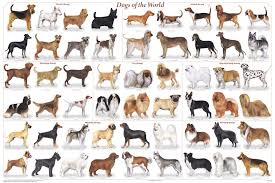Dog, (Canis lupus familiaris), domestic mammal of the family Canidae (order Carnivora). It is a subspecies of the gray wolf (Canis lupus) and is related to foxes and jackals. The dog is one of the two most ubiquitous and most popular domestic animals in the world (the cat is the other).
For more than 12,000 years it has lived with humans as a hunting companion, protector, object of scorn or adoration, and friend. The dog evolved from the gray wolf into more than 400 distinct breeds.
Human beings have played a major role in creating dogs that fulfill distinct societal needs. Through the most rudimentary form of genetic engineering, dogs were bred to accentuate instincts that were evident from their earliest encounters with humans.
Although details about the evolution of dogs are uncertain, the first dogs were hunters with keen senses of sight and smell. Humans developed these instincts and created new breeds as need or desire arose.
Dogs are regarded differently in different parts of the world. Characteristics of loyalty, friendship, protectiveness, and affection have earned dogs an important position in Western society, and in the United States and Europe the care and feeding of dogs has become a multibillion-dollar business.
Western civilization has given the relationship between human and dog great importance, but, in some of the developing nations and in many areas of Asia, dogs are not held in the same esteem.
In some areas of the world, dogs are used as guards or beasts of burden or even for food, whereas in the United States and Europe dogs are protected and admired. In ancient Egypt during the days of the pharaohs, dogs were considered to be sacred.
Dogs have played an important role in the history of human civilization and were among the first domesticated animals. They were important in hunter-gatherer societies as hunting allies and bodyguards against predators.
When livestock were domesticated about 7,000 to 9,000 years ago, dogs served as herders and guardians of sheep, goats, and cattle. Although many still serve in these capacities, dogs are increasingly used for social purposes and companionship.
Today dogs are employed as guides for the blind and disabled or for police work. Dogs are even used in therapy in nursing homes and hospitals to encourage patients toward recovery.
Humans have bred a wide range of different dogs adapted to serve a variety of functions. This has been enhanced by improvements in veterinary care and animal husbandry.
Read Also: Are you barking up the wrong tree by sleeping with your dog?
Origin and History of Dogs: Ancestry

Paleontologists and archaeologists have determined that about 60 million years ago a small mammal, rather like a weasel, lived in the environs of what are now parts of Asia. It is called Miacis, the genus that became the ancestor of the animals known today as canids: dogs, jackals, wolves, and foxes. Miacis did not leave direct descendants, but doglike canids evolved from it.
By about 30 to 40 million years ago Miacis had evolved into the first true dog namely, Cynodictis. This was a medium-size animal, longer than it was tall, with a long tail and a fairly brushy coat.
Over the millennia Cynodictis gave rise to two branches, one in Africa and the other in Eurasia. The Eurasian branch was called Tomarctus and is the progenitor of wolves, dogs, and foxes.
The timing and location of dog domestication is less clear and has been a matter of significant debate, but there is strong genetic evidence that the first domestication events occurred somewhere in Central Asia before 15,000 years ago. Some genetic studies have suggested that wolves were domesticated 16,300 years ago to serve as livestock in China.
Other genetic studies, however, have suggested that dog domestication began as early as 18,800–32,100 years ago in Europe or that early dogs dating from about 12,000 to 14,000 years ago came from a small strain of gray wolf that inhabited what is now India. Thereafter this wolf known as Canis lupus pallipes was widely distributed throughout Europe, Asia, and North America.
However, one genetic study that compared the DNA of dogs and wolves inhabiting areas thought to have been centres of dog domestication suggests that dogs and modern wolves belong to separate lineages that share a common ancestor. It is also possible that some of the dogs of today descended not from the wolf but rather from the jackal.
These dogs, found in Africa, might have given rise to some of the present native African breeds. A genetic study examining the migration of dogs to the Americas revealed evidence that dogs did not accompany the first humans to the New World more than 15,000 years ago; the study suggested that dogs came to the Americas only 10,000 years ago.
No matter what their origins, all canids have certain common characteristics. They are mammals that bear live young. The females have mammary glands, and they suckle their offspring. The early breeds had erect ears and pointed or wedge-shaped muzzles, similar to the northern breeds common today.
Most of the carnivores have similar dental structures, which is one way paleontologists have been able to identify them. They develop two sets of teeth, deciduous (“baby”) teeth and permanent teeth.
Canids walk on their toes, in contrast to an animal like the bear, which is flat-footed and walks on its heels. Dogs, like most mammals, have body hair and are homeothermic that is to say, they have an internal thermostat that permits them to maintain their body temperature at a constant level despite the outside temperature.
Fossil remains suggest that five distinct types of dogs existed by the beginning of the Bronze Age (about 4500 bce). They were the mastiffs, wolf-type dogs, sight hounds (such as the Saluki or greyhound), pointing dogs, and herding dogs.
Read Also: Products That Can Be Derived From Metabolic wastes

